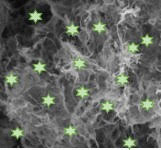Nanocellulose based-material for wound dressing
This review article aims at giving insight into cellulose-based nanomaterials and their potential use for wound dressing applications. The first part focuses on nanocellulose particles, including their production, properties and assembly into highly organized materials. The design of 2D (films and nanopapers) and 3D structures (cryogels and aerogels) is further discussed, followed by examples of the application of nanocellulose-based materials in the biomedical field will be presented.

The benefits of using nanocellulose-based materials for wound-dressing applications is considered and discussed in the second part. There is first, an introduction to microbiology and microorganisms encountered in wound infections. Then, bio-based wound dressings and related requirements is assessed. Finally, the elaboration and characterization techniques of bioactive materials is described. Nanocellulose functionalization is discussed in the last section. The range of nanocellulose modification in green and traditional solvents is extended to newer and innovative solutions for “green” functionalization with apolar solvents, with a special focus on the use of supercritical carbon dioxide.
https://www.glycopedia.eu/e-chapters/nanocellulose-based-material-for-wound-dressing/article/introduction




